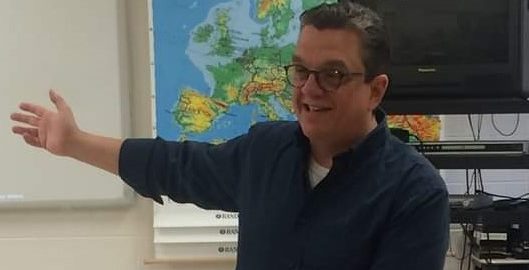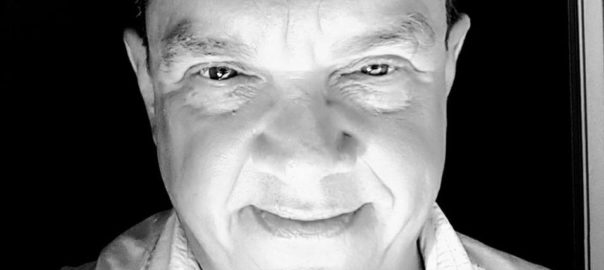Dear friends,
My earliest memory of Big Sandy School is a scary one.
When Tim, my older brother, was in the first grade, my mother brought all three of us, with Greg just a two-year-old, to the school library for a PTC meeting. Someone had the idea to take all the children who were big enough to the gym to run and play while the adults did Parent-Teacher Conference business. One of the aging, gray-haired ladies with cat-eye glasses who seemed to run everything in that long-ago time agreed to supervise. Greg stayed behind, of course, but Tim and I joined in with some other kids and went into that vast, cavernous space with the devil’s face painted in the middle of the floor. I was four and had almost never been away from my mother, except with relatives, and I was not a fan of the devil’s face (no cartoon devil he), so I protested—loudly. Concluding that I was too young to participate without being a pain, the old lady sent me back. Someone escorted me into the door of the school building and left me there. The hall lights were not even on. All good mothers can recognize their children’s shrieks, and no one had a better mother than I did, so my shrieks came loudly and clearly, and Mom came running. I was none the worse for wear, but I do remember it, and Mom told that story with a flash of anger for the next fifty years.
That was in 1969.
I suppose Big Sandy School has always been a part of me.
I was a student at Big Sandy from 1971 until I graduated in 1983. Believe me, it was no part of my plan to return. I loved living in Knoxville, and I wanted to be a lawyer, but like the protagonist in Mr. Holland’s Opus (or like Gabe Kotter, if you prefer a less ostentatious simile) I felt at times that fate was conspiring behind the scenes not just to push me into a classroom, but to push me back to my old school. My brother Tim’s long struggle with Lou Gehrig’s disease, my discovery that I did not like the law nearly as much as I liked the history of the law, and changes in my own life led to a teaching license in 1990 and, in the fall of 1995, to Big Sandy School. I didn’t seek the job; it sought me. I didn’t even apply for it. Sometimes the world works that way.
For the first three years I was a teacher at Big Sandy, I did not even have a classroom. Many of you remember what it was like there in those days, with K-12 in one building: halls so crowded between classes that you could barely move; courses meeting in dressing rooms, storage rooms, and abandoned bathrooms; teachers having to vacate their rooms during planning time so someone else could teach there. In the fall of 1998, the new high school building opened. I found my new quarters, unfurled my maps, grabbed a cup of coffee, and room 208 at the end of the hall became the nerve center of history education on the north end of Benton County.
Now, 28 years after I returned, the halls aren’t crowded anymore, there are rooms to spare, and I have been teaching two classes per day in Camden since August. Whatever accidents or designs of fate led me, all those years ago, back to where I started and into room 208, where no one else has ever taught, have changed course. On May 19, I will teach my last class at Big Sandy. Next year, along with the high school student body, I will be relocating full time to Camden Central High. I knew this day was coming, but I have heard people talk about it since the 1970s, and when you hear something discussed for that long it becomes difficult to think of it as real.
I have long cast nervous glances at the changing landscape of my workplace, with so many old friends and mentors gone and so much energy lost, and wondered how it would all turn out. In my personal daydream, Big Sandy High’s last day always came on my last day as a teacher. I would make a General MacArthur-like valedictory address to the masses, bask in their applause and adulation, and the school and I would fade away together. It wasn’t to be, though. It’s too soon to retire, and now I face a difficult task, a task complicated by my age, of which I am increasingly aware. I have to transplant what I hope was a worthwhile career, one that touched people’s hearts and minds, into a new and bigger place where the magic—and at times it did feel like magic—may not work. If the magic fails, it will not be the fault of the people of Camden Central High School, where I have good friends, some of whom were once colleagues at Big Sandy. The people there have welcomed me with warmth and support, and the administrators of both the school and the district have done everything in their power to smooth this transition.
Twenty-eight years ago, I was at the bottom of my own school’s seniority list; today I am number 25 for the entire district. For all those years moving up the list, I am indebted to many people associated with Big Sandy School, but for fear of leaving someone out I am going to name only one. It was Mrs. Diane Padgett who reached out to me and offered me this job; she always, always believed I had “it,” whatever “it” is, and she was happy to have me back. That was a life-changing phone call, and I am eternally grateful to her.
I will not lie; it is going to be painful to walk out of BSHS. I have probably spent more time in my Big Sandy School classroom than in any home I have ever lived in, and I suspect I have spent more of my life on the school’s few acres of land than in any other place. I am ambivalent as to whether that denotes success or failure on my part. I have been able to impact a lot of lives there, and I do hope that most of those people believe they have benefited from my efforts. There have been many times when I reflected that I once had “bigger” dreams, but then I look around and see people with “bigger” lives who have little to feel good about at the end of the week. I never had that problem. My work at our little school was difficult, frustrating, and sometimes infuriating, but it was work that mattered, and that, my friends, is priceless.
So, thank you, Big Sandy, for your tireless support of my efforts to teach at your—our—school. When you pause to think of it, it is quite something to have people entrust their children to you, day after day, for so many years. It was a real honor, and I learned at least as much from the students as they learned from me.
To the surprise of no one, I will close with an anecdote from history. In February 1861, with the country going to pieces, president-elect Abraham Lincoln left his adopted hometown of Springfield, Illinois to travel to the nation’s capital, “not knowing when or whether ever” he would return (he did not). He left to me a better closing line for my career at Big Sandy than I could ever write for myself:
“My friends, no one, not in my situation, can appreciate my feeling of sadness at this parting. To this place, and the kindness of these people, I owe everything.”
K.T.B
May 2023

